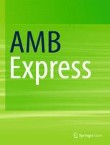Springer Nature announces an opportunity for an exceptional candidate to serve as Editor-in-Chief for the journal AMB Express (AMBE).
AMBE is a high-quality Open Access journal that brings together research in the area of Applied and Industrial Microbiology with a particular interest in 'White Biotechnology' and 'Red Biotechnology'. The emphasis is on processes employing microorganisms, eukaryotic cell cultures or enzymes for the biosynthesis, transformation and degradation of compounds. This includes fine and bulk chemicals, polymeric compounds and enzymes or other proteins. Downstream processes are also considered. Integrated processes combining biochemical and chemical processes are also published.
Reports on the use of new procedures or tools in a clinical setting are only considered for publication if microorganisms, viruses, enzymes or other proteins from microorganisms or metabolites of microorganisms are involved as crucial and central part of the new procedure or tool.
The journal Impact Factor (2022) is 3.7, and it received over a million article downloads in 2023.
The current Editor-in-Chief, Prof. Alexander Steinbüchel, will conclude his term of office in December 2024, and we are looking to recruit a successor who would start working in early autumn 2024 with a gradual handover of duties from the current editor and become fully installed as of January 2025.
The appointment will be for a three-year term and includes an annual editorial stipend. The position is open to highly regarded experts in applied microbiology with international recognition and proven scientific leadership in a renowned academic or research institution.
Candidates should have a PhD or equivalent degree and be able to demonstrate a strong research and publication record. Prior experience in peer-review activities and other editorial functions is highly desirable. We are searching for a motivated and enthusiastic scientist with a vision of growing and developing the journal to serve the scientific community even better.
Responsibilities include working alongside the Associate Editors to manage the peer review of manuscripts under consideration by the journal, closely collaborating with the publisher to select Editors and the Editorial Board, and commissioning submissions in areas of interest and scope. The Editor-in-Chief will work routinely with Springer Nature on journal development with the goal of furthering the journal’s impact and reach.
Responsibilities of the Editor-in-Chief include:
● Working in consultation with the Journal Editors or other Editors that may be appointed, the Editor-in-Chief will exercise control of the editorial development and editorial content of the journal and oversees the application of high editorial standards to all published contributions.
● Supplying the Publisher with refereed and accepted manuscripts and other editorial material, prepared in accordance with the guidelines to authors.
● In consultation with Publisher, selecting Editors and an Editorial Board that provides both international representation and diverse expertise.
● Soliciting high quality reviews and other commissioned content on topics of interest.
● If they desire, to periodically select Guest Editors who shall be responsible for soliciting and acquiring manuscript for topical collections.
● To use their best efforts to promote and to assist the Publisher in promoting the journal at relevant meetings, online and within the appropriate scientific communities.
● Checking the content of the journal with a view to ensuring that there are no material infringing editorial policies. They will also promptly inform the Publisher of any resulting issues, and be available to discuss and support resulting issues.
● Supporting ongoing diversity and inclusion goals in helping to ensure the journal is reflective of the global community that it serves.
● Adhering to standards of editorial good practice, as defined in the Publisher’s Code of Conduct for Editors-in-Chief. The Code is based on guidelines and best practice recommendations issued by organizations such as the Committee of Publication Ethics (COPE).
● Participating in Springer Nature’s Transfer Service by offering the transfer option, where appropriate, to authors whose manuscripts have been rejected from the journal, and considering manuscripts received by through the Transfer Service.
● Participating in regular meetings with the Publisher as well as an Annual Editorial Board meeting, to discuss the ongoing development of the journal and to set and accomplish journal development goals.
All applications should be sent to Barbara Zöhrer, Senior Publisher, at barbara.zoehrer@springernature.com by 15 May 2024.
Candidates should include the following documents with their formal application:
• Cover letter (max. 2 pages) summarizing their qualifications and motivation, including an explanation why they consider themselves suitable for the position.
• Curriculum vitae (max. 3 pages) including relevant publications and achievements.
• Vision statement (max. 3 pages) addressing the following points:
- Analysis of the current situation of AMB Express
- Vision and strategy for further enhancing the journal through editorial aspects
- Strategy on encouraging and building a supportive and inclusive culture based on the values of diversity, equity, and inclusion for the Editorial Board.

